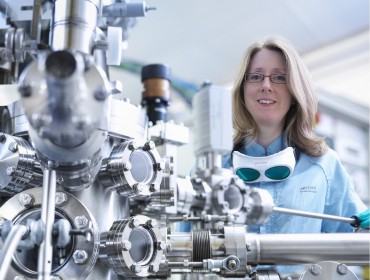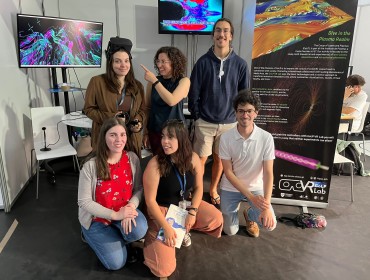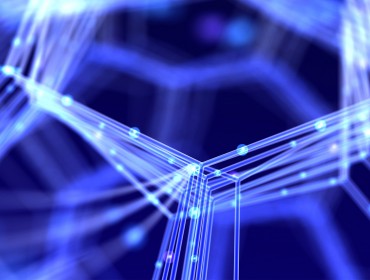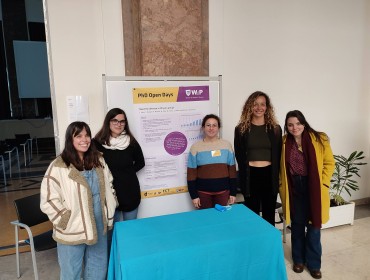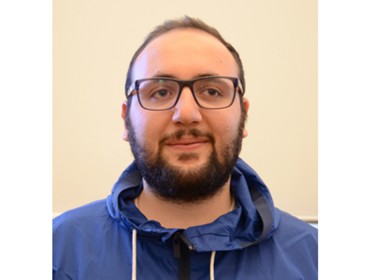-
LPAW'23 organized by GoLP, more information coming soon
Read moreGoLP is organizing the 2023 Laser and Plasma Accelerator Workshop (LPAW’23) to be held March 6-10, 2023, in Lagos, Portugal. Stay tuned for more information coming soon here.
July 8, 2022 -
EPP members Bernardo Malaca and Rui Torres awarded EPS-DPP Poster Prizes 2022
Read moreAt the closing session of the 48th EPS Plasma Physics Conference (fully virtual), the posters of Rui Torres and Bernardo Malaca were announced as winners of the EPS-DPP best poster awards 2022. They received this award presenting the work with the title “General relativity particle-in-cell simulations of compact neutron star magnetospheres” and “Superradiance from superluminal nonlinear plasma wakefields”.
July 1, 2022 -
Next GoLP VIP Seminar "Science at Artemis" by Dr Emma Springate
Read moreNext Wednesday, 15 of June from 11:30 to 12:30, there will be our next GoLP VIP Seminar, by Dr Emma Springate (Rutherford Appleton Laboratory (STFC) – UK). The event will take place at Anfiteatro Abreu Faro – Complexo I at IST.
Abstract:
Artemis is based on high repetition rate, few optical cycles and widely tuneable laser sources, and ultrafast XUV (10-100 eV) pulses produced through high harmonic generation. Vacuum beamlines deliver the synchronised pulses to end-stations for condensed matter physics and gas-phase chemistry. Experiments on Artemis use high harmonic generation to investigate ultrafast dynamics in experiments on gas, liquid and solid materials. The team also exploits the spatial coherence of the XUV to use coherent diffractive imaging techniques.Artemis operates lasers very similar to the VOXEL station (800 nm), and the L2I (3 µm) and their secondary sources, for external users, for several years now. Its successful development of an external user…
June 13, 2022 -
Upcoming MRE Webinar with the EPP member Marija Vranic
Read moreOn June 14th, 2022, 9 am EDT (2 pm WET), our EPP member Marija Vranic will present at a Matter and Radiation at Extremes (MRE) webinar.
MRE is committed to publishing original and impactful research and review papers that address extreme states of matter and radiation, and the associated science and technology employed to produce and diagnose these conditions in the laboratory. Drivers, targets and diagnostics are included along with related numerical simulation and computational methods. It aims to provide a peer-reviewed platform for the international physics community and promote worldwide dissemination of the latest and impactful research in related fields.
For more information, and for the link to the webinar with the title Plasma in extreme fields: challenges and opportunities, which is free and open to the public, please click here.
June 13, 2022 -
GoLP members participation in outreach event for Dia do Técnico 2022
Read moreDuring this year’s Técnico 111º anniversary, on the 23rd of May 2022, some of our GoLP members participated actively in the outreach event for the Science Fair for Dia do Técnico 2022. For more information about the event, click here.
We had the opportunity to let hesitant children and visitors step into our plasma simulation world through our GoLP Virtual Reality Lab. Having the possibility to participate in outreach events represents a great opportunity for researchers to stimulate the interest of the public in what they are studying and investigating.
Here we show some pictures from the event. Thank you to everybody that had an active part in the event.
May 31, 2022 -
Professor Marta Fajardo awarded Prix Tremplin Mariano Gago award for NanoXIMAGES project
Read moreConsidering the year of the Portugal-France Season 2022 and with the support of the French Ministry of Europe and Foreign Affairs, the French Ministry of Culture, the Camões Institute – Institute of Cooperation and Language and the Office of Cultural Strategy, Planning and Evaluation (GEPAC), the Ministry of Higher Education, Research and Innovation of France (MESRI) and the French Academy of Sciences awarded four Prix Tremplin Mariano Gago awards. Four scientific pairs were awarder with 84.000 euro. In particular, Professor Marta Fajardo, professor of the Department of Physics (DF) and researcher of the Institute of Plasmas and Nuclear Fusion (IPFN), and Professor Hamed Merdji, with the NanoXIMAGES project. The project proposed has practical application in the aria of nanotechnologies, aiming to prove that it is possible to reconstruct an X-ray image of an object through a process with incoherent light. This technique has a strong applicability for the area of medicine and…
May 19, 2022 -
Training event on "Modelling of ultra-intense laser propagation in plasmas and laser-plasma accelerators: fundamentals" organized by GoLP
Read moreFor PhD students/post-docs/researchers in laser-plasma interactions, this training event is dedicated to the fundamentals of computational modeling of intense laser pulse propagation in plasma, and applications to compact laser plasma-based accelerators. Laser plasma accelerators are one of the most exciting applications of intense lasers and computational modeling plays a critical role in the design and optimization of laser plasma accelerators.
The event, organized in collaboration with Laserlab, takes place over the course of 4 days, with a 2 hour lecture per day where participants will learn the basics of pulse propagation in plasma, and the principles of state-of-the-art laser-plasma computational tools, how to use these tools and perform data analysis.
The computational tool to be used is ZPIC, complemented by Jupyter notebooks. It is a fully relativistic, electromagnetic, and open-source particle-in-cell code. ZPIC builds on the state-of-the-art particle-in-cell OSIRIS, and it features all the basic ingredients of the particle-in-cell scheme without…
April 27, 2022 -
Modeling Earth's magnetosphere in the laboratory in Physics of Plasma
Read moreIn Physics of Plasmas, a collaboration of scientists from Princeton, UCLA, and Instituto Superior Técnico, reports a method to study smaller magnetospheres, sometimes just millimeters thick, in the laboratory.
A magnetized object, such as our planet Earth, is immersed within a stream of ionized gas, called plasma. The region around the object in which this effect is seen is called a magnetosphere.
The Earth’s large magnetosphere that extends out into space, has also the fundamental role of blocking lethal cosmic rays and particles from the sun and stars and allowing life itself to exist.These mini-magnetospheres have been observed around comets and near-certain regions of the moon and have been suggested to propel spacecraft. They are good testbeds for studying larger planet-sized magnetospheres.
Previous laboratory experiments have been carried out utilizing plasma wind tunnels or high-energy lasers to create mini-magnetospheres. However, these earlier experiments were limited to 1D measurements of magnetic fields that…
April 15, 2022 -
33 million core hours awarded to EPP members through the European High Performance Computing Joint Undertaking
Read moreEPP team members Luis O. Silva (PI) and Pablo J. Bilbao (co-Pi) have been awarded a total of 33 million core hours at the LUMI supercomputer located in Kajaani, Finland. LUMI is one of the pan-European pre-exascale supercomputers funded in part by the EuroHPC Joint Undertaking. Who awarded the computational time during the EuroHPC Regular Access call on December of 2021. The project CREPE: Coherent Radiation mechanisms in Extreme Plasma Environment which aims to study plasmas under extreme conditions to address how non-thermal, coherent emission is produced in extreme environments. The project will take advantage of the latest developments by the group to include general relativity and QED effects into account.
March 28, 2022 -
ERC Consolidator Grant for the GoLP alumnus Frederico Fiúza
Read moreThe former GoLP PhD student Frederico Fiúza has been recently awarded a Consolidator Grant from the European Research Council for his Project XPACE: Extreme Particle Acceleration in Shocks: from the laboratory to astrophysics. In the scope of this project, Frederico will move back to Portugal and carry out his research at IST. The grant will provide 1.8 million euros funding for a period of five years.
Astrophysical shocks, generated by violent interactions of supersonic plasmas, are among the most powerful particle accelerators in the Universe. Over the past decade, discoveries linked to plasmas outside of our own solar system have excited scientists and the public alike. We have been able to observe extraordinary phenomena such as cosmic-ray acceleration in the remnants of supernovae, gravitational waves and their electromagnetic counterparts from neutron star mergers, and jets coming from supermassive black holes. However, the underlying physics of particle acceleration in astrophysical shocks is not yet well understood,…
March 18, 2022 -
GoLP for Ukraine
Read moreGoLP supports several full time research fellowships (at MSc, PhD, or post-doc level) for students/researchers from Ukraine (with backgrounds in physics, electrical engineering, applied mathematics, or computer science) in topics of our research portfolio (exp-theory-simulations) that covers laser-plasma physics, lasers, optics, plasma astrophysics, warm dense matter, light sources, high-performance computing, numerical simulations, laser technology (for details check our website http://golp.tecnico.ulisboa.pt and the websites of our two main teams: http://xgolp.tecnico.ulisboa.pt and http://epp.tecnico.ulisboa.pt). We also cover tuition and fees for students transferring to a degree at Instituto Superior Tecnico.
For more information email luis.silva@tecnico.ulisboa.pt.
March 14, 2022 -
George Vahala to give a talk on February 25th, 4pm WET (11am Boston)
Read moreSpeaker: George Vahala
Title: Qubit Lattice Algorithm for the Electromagnetic Pulse Propagation in Scalar Dielectric Media
Abstract: There is much interest in examining plasma problems that will be amenable to error-correcting quantum computers. For some years, we have been developing Qubit Lattice Algorithms (QLA) for the solution of nonlinear physics – in particular the Nonlinear Schrodinger Equation (NLS)/Gross Pitaevskii equation in 1D-2D-3D. The 1D soliton physics benchmarked our algorithms, while in 3D we examined scalar quantum turbulence, finding 3 energy cascades on a 5760³ grid using 11k processors (2009). For spinor BEC simulations the QLA were ideally parallelized on classical supercomputers (tested to over 760k cores on IBM Mira). QLA is a mesoscopic representation of interleaved non-commuting sequence of collision/streaming operators which in the continuum limit perturbatively reproduce the physics equations of interest. The collision operators entangle the local on-site qubits, while the streaming operators spread this entanglement throughout the lattice….
February 21, 2022 -
Professor Marija Vranic Wins the 2022 PRACE Ada Lovelace Award for HPC
Read moreThe EPP member and invited Professor at the Instituto Superior Técnico of the University of Lisbon, Marija Vranic, is the winner of the 2022 PRACE Ada Lovelace Award for HPC for her outstanding impact on HPC in Europe. Dr. Vranic has not only pioneered techniques for simulating extreme plasmas, but she is also actively involved in improving the visibility of women in physics and HPC — for instance, by reducing the gender imbalance of invited speakers at scientific conferences and mentoring the Women in Physics student group at IST.
Many congratulations to Marija!
February 21, 2022 -
Professor Ricardo Fonseca on Antena 1
Read moreRicardo Fonsenca, research member of GoLP, talked about his work on ’90 segundos de ciência’. In this brief interview, Ricardo presented the many applications of computational plasma physics, the recent collaboration with CERN’s AWAKE experiment, and how plasma particle accelerators will revolutionize techniques in medicine and industry.
February 21, 2022 -
Andrew Baczewsk to give a talk on January 28th, 16h Lisbon (8h California)
Read moreSpeaker: Andrew Baczewsk
Title: Prospects for simulating warm dense matter on quantum computers
Abstract:Warm dense matter is typified by the coexistence of electron degeneracy and thermal effects. The quantum nature of the constituent electrons requires that their dynamics obey the Schroedinger equation, the solution of which suffers from a notorious curse of dimensionality. The cost of curing this curse on classical computers is a dilemma – the choice between accuracy and efficiency. But quantum computers promise to enable us to have both accuracy and efficiency. In this talk, I will describe the prospects for realizing this in the context of simulating warm dense matter. First, I will motivate the need for quantum simulation with a discussion of the state of the art in simulation on classical computers. Then, I will describe work that our group has done to improve the efficiency of simulation algorithms in the NISQ era. Finally, I will provide estimates for what it will take to realize significant…
January 13, 2022 -
News piece at SIC, with Luís O. Silva
Read more“Solid, liquid, or gas? What is the state of matter of the stars?”
Introducing the concept of plasma, and finally guiding us toward the enigma of the pulsars, check out the news piece at SIC, with Luís O. Silva.
December 21, 2021 -
Women in Physics group awarded an APS Grant
Read moreThe Women in Physics group, which was founded in 2020 by EPP team members Camilla Willim, Marija Vranic, Mariana Moreira, and Chiara Badiali, later joined by GoLP members Joana Alves and Mariana Silva, was awarded the Women in Physics Group Grant, worth 1000$ by the American Physical Society.
This is the first time this grant has been awarded to a group in Europe.
The Women in Physics group is committed to raising the proportion of women in Physics, as well as improving working conditions.
Find out more about the group’s activities on their website and social media:
Facebook: Women in Physics – IST
Instagram: wip.ist
Twitter: IstWip
December 20, 2021 -
GoLP members collaborate in the new AWAKE publication
Read moreThe AWAKE Collaboration, of which GoLP members Ricardo Fonseca, Nelson Lopes, Mariana Moreira, Jorge Vieira, Luis O. Silva, and Nuno Torrado are part, has published today an “Analysis of proton bunch parameters in the AWAKE experiment”, in the Journal of Instrumentation. This work offers a precise characterization of the incoming proton bunch parameters, crucial to accurately simulate one of the most important parts of the AWAKE experiment: the self-modulation process.
November 26, 2021 -
APPLAuSE student Mario Galletti awarded for the Best PhD Thesis in Optics and Photonics in Portugal, 2020
Read moreThe APPLAuSE student Mario Galletti has received the award for the Best PhD Thesis in Optics and Photonics in Portugal, 2020, sponsored by the Portuguese Society for Optics and Photonics – SPOF.
The thesis, with the title of “High contrast front-end for a petawatt laser system designed for electron acceleration & High-intensity laser-matter applications towards advanced compact particle accelerators” was supervised by Prof. Gonçalo Figueira (Instituto Superior Tecnico, Universidade de Lisboa) and Dr. Marco Galimberti (Central Laser Facility, Rutherford Appleton Laboratory, Oxford).
November 17, 2021 -
EPP GoLP member awarded second place in the APS DPP 2021 Visual Science Communication contest
Read moreEPP GoLP member awarded second place in the APS DPP 2021 Visual Science Communication contest during the 63rd Annual Meeting of the APS Division of Plasma Physics, held in a hybrid format on November 8-12 2021.
Pablo J. Bilbao was awarded the 2nd place video award in the APS DPP 2021 Visual Science Communication. The video featured the research presented in his poster during the conference, with the title a self-consistent study of the electron cyclotron maser instability as a source of coherent radiation.
November 15, 2021
Group for Lasers and Plasmas > News



